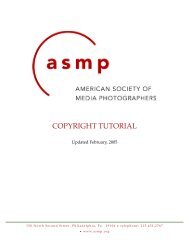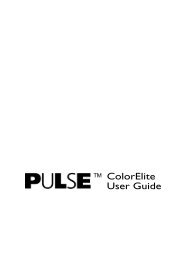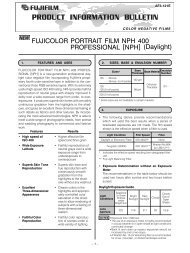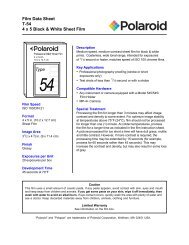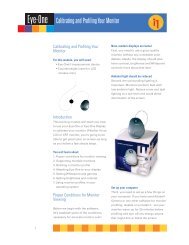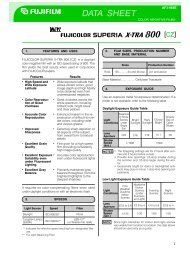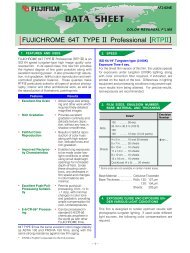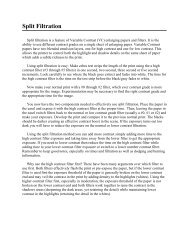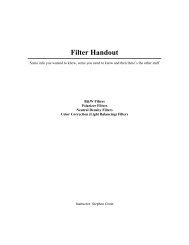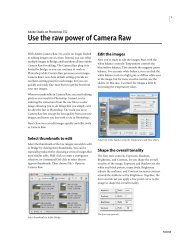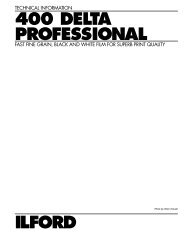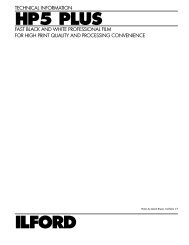FUJICOLOR NPH 400 PROFESSIONAL [NPH] - Fujifilm USA
FUJICOLOR NPH 400 PROFESSIONAL [NPH] - Fujifilm USA
FUJICOLOR NPH 400 PROFESSIONAL [NPH] - Fujifilm USA
You also want an ePaper? Increase the reach of your titles
YUMPU automatically turns print PDFs into web optimized ePapers that Google loves.
DATA SHEET<br />
COLOR NEGATIVE FILMS<br />
<strong>FUJICOLOR</strong> <strong>NPH</strong> <strong>400</strong> <strong>PROFESSIONAL</strong> [<strong>NPH</strong>]<br />
AF3-865E<br />
1 FEATURES AND USES<br />
<strong>FUJICOLOR</strong> <strong>NPH</strong> <strong>400</strong> <strong>PROFESSIONAL</strong> [<strong>NPH</strong>] is an ISO<br />
<strong>400</strong> rated, daylight-type color negative film designed for<br />
portrait, wedding photography and other commercial<br />
applications.<br />
Incorporating the most advanced FUJI technology, this<br />
film is able to meet the wide-ranging demands of photographers.<br />
Features<br />
• High Speed of ISO <strong>400</strong><br />
• Optimized Skin Tone<br />
Reproduction<br />
• More Accurate Color<br />
Reproduction<br />
• Fine Grain Equal to<br />
ISO 100<br />
• Rich Gradation and<br />
Uniform Gray Balance<br />
• Exceptionally Wide<br />
Latitude<br />
Results<br />
• Accurate ISO <strong>400</strong> rating for<br />
versatility and superb results<br />
on a wide range of photographic<br />
assignments<br />
• Smooth, natural and unbiased<br />
skin tones in portrait and<br />
wedding photography where<br />
skin tone is of utmost importance<br />
• Moderate color saturation to<br />
produce subtle and accurate<br />
color tones required in professional<br />
work<br />
• Fine grain performance allows<br />
enlargements to be made<br />
with confidence<br />
• Fine detail in highlights and<br />
shadows<br />
• Neutral tone over entire density<br />
range<br />
• Good results in significant<br />
over and under exposure situations<br />
2 SIZES, BASE AND EMULSION NUMBER<br />
Sizes<br />
135 36-exp.<br />
135 36-exp.<br />
(5-roll packs)<br />
120<br />
120 (5-roll packs)<br />
220 (5-roll packs)<br />
Base<br />
Thickness<br />
122 µm<br />
(4.8 mil)<br />
104 µm<br />
(4.0 mil)<br />
Base Material<br />
Cellulose<br />
Triacetate<br />
Emulsion<br />
Number<br />
101 – 199<br />
3 FILM SPEED<br />
Light Source Film Speed Filter Requirements<br />
Daylight ISO <strong>400</strong>/27° None<br />
Tungsten (3200K) ISO 100/21°*<br />
* Indicates the effective speed resulting from designated<br />
filter use.<br />
** Fuji Light Balancing Filter.<br />
4 EXPOSURE GUIDE<br />
LBB-12 **<br />
(or Kodak No. 80A)<br />
• Exposure Determination without an Exposure<br />
Meter<br />
When an exposure meter is not available, use the<br />
following table as a guide to exposure determination.<br />
Daylight Exposure Guide<br />
(Shutter Speeds: 1/500 sec.)<br />
Light<br />
Conditions<br />
Lens<br />
Aperture<br />
Seashore<br />
or Snow<br />
Scenes<br />
Under<br />
Bright<br />
Sun<br />
Bright<br />
Sunlight<br />
Hazy<br />
Sunlight<br />
Cloudy<br />
Bright<br />
Cloudy<br />
Day or<br />
Open<br />
Shade<br />
f/22 f/16 f/11 f/8 f/5.6<br />
NOTES • This table applies for conditions prevaling from 2<br />
hours after sunrise until 2 hours before sunset.<br />
• The use of an exposure meter is highly recommended<br />
in cloudy weather or in open shade<br />
since light intensity differentials are under continual<br />
flux.<br />
• Apertures increased by one or two stops are usually<br />
suitable for back-lighted close-up subjects.<br />
Low Light Exposure Guide<br />
Fine Nighttime<br />
Light Weather Indoor<br />
Conditions Daytime Scenes (under<br />
fluores-<br />
Indoor<br />
Scenes cent light)<br />
Lens<br />
Aperture<br />
Shutter<br />
Speed<br />
(sec.)<br />
NOTE<br />
Evening<br />
Scenes<br />
Night<br />
Scenes<br />
f/2.8 to 4 f/2 to 2.8 f/2.8 to 4 f/2 to 2.8<br />
1/60 1/30 1/60 1/30<br />
For indoor and night scenes, illumination levels differ<br />
widely from place to place. Use the table as a guide<br />
only.<br />
1
FUJIFILM DATA SHEET • <strong>FUJICOLOR</strong> <strong>NPH</strong> <strong>400</strong> <strong>PROFESSIONAL</strong> (<strong>NPH</strong>)<br />
5 EXPOSURE UNDER VARIOUS LIGHT CONDI-<br />
TIONS<br />
Daylight<br />
Under daylight conditions color balancing filters are not<br />
necessary, but the following exposure conditions may<br />
require the indicated filters.<br />
Subject Conditions<br />
Fair weather open shade and shaded landscapes<br />
Bright distant scenes, snow landscapes, seaside<br />
scenes, aerial scenes and open landscapes<br />
* Fuji Sharp Cut Filters (Ultraviolet)<br />
** Kodak Filters<br />
Filter<br />
SC-39 *<br />
(No. 2C **)<br />
SC-40M *<br />
(No. 1A **)<br />
Excessively high or low subject color temperatures may<br />
require the following filter additions and exposure corrections.<br />
Lens<br />
Aparture<br />
Subject Conditions<br />
High Color Temperature: Cloudy weather<br />
landscapes and portaits or clear<br />
weather open shade subjects<br />
Low Color Temperature: Scenes and portraits<br />
under morning or evening twilight<br />
condtions<br />
* Fuji Light Balancing Filters (Ultraviolet)<br />
** Kodak Filters<br />
NOTE<br />
=<br />
Filter<br />
LBA-2 *<br />
(No. 81A **)<br />
LBB-2 *<br />
(No. 82A **)<br />
When using artifical illumination either as the main or<br />
auxiliary light source with sunlit subjects either indoors<br />
or out, it is important to use either blue flash<br />
bulbs or electronic flash.<br />
Electronic Flash<br />
• Since electronic flash characteristics are similar to<br />
daylight, no filters are required. Effective light output<br />
and color balance will differ with the equipment<br />
type, age, color temperature and other factors. This<br />
will require making initial tests.<br />
• With shutter speeds slower than 1/60 of a second,<br />
the influence of non-flash light sources such as modeling<br />
lamps and room illumination may cause undesirable<br />
color balance shifts. Test exposures are recommended.<br />
• Adjust the lens opening for electronic flash according<br />
the following formula;<br />
ISO <strong>400</strong> Electronic Flash Guide Number<br />
Electronic Flash-to-Subject Distance (in Meters)<br />
• The film speed should be set at the ISO setting currently<br />
being used for ISO <strong>400</strong> rated film.<br />
• Since the amount of light reflected onto the subject<br />
from surrounding surfaces will differ with conditions,<br />
refer to the instructions for the flash unit.<br />
Flash Bulbs<br />
• With blue flash bulb exposures, compensating filters<br />
are unnecessary but with clear flash bulbs a Fuji<br />
LBB-8* (No. 80C or 80D**) filter should be used.<br />
• Light quality will vary with bulb manufacture while<br />
variations will also depend on lighting equipment<br />
and related diffusion techniques. Make test exposures.<br />
* Fuji Light Balancing Filters<br />
** Kodak Filters<br />
Daylight Photoflood Lamps<br />
• Daylight photoflood lamps tend to result in underexposure,<br />
so it is sometimes essential to increase exposure<br />
light output beyond that indicated by an exposure<br />
meter.<br />
• Color balance and light output will differ with lamp<br />
configulation, use duration and applied voltage. It is<br />
essential that exposure conditions be determined in<br />
relation to the particular lighting equipment employed.<br />
Fluorescent and High-intensity Discharge Lamps<br />
This film will provide the best results when exposed to<br />
fluorescent and H/D lamp light if the following filter and<br />
exposure recommendations are applied. Fluorescent<br />
and H/D lamps are subjected to color and brightness<br />
variations during alternating-current cycles.<br />
To avoid related variability problems, expose <strong>NPH</strong> at<br />
speeds longer than 1/125 sec with H/D or 1/60 sec for<br />
fluorescent lamps. If accurate color renditions are essential<br />
it is best to make test exposures for determining<br />
color and density under actual use conditions.<br />
Fluorescent<br />
Lamp Type<br />
Color Compensating<br />
Filters *<br />
Exposure<br />
Correction<br />
**<br />
Daylight<br />
(D)<br />
Cool<br />
White<br />
(CW)<br />
White<br />
(W)<br />
Warm<br />
White<br />
(WW)<br />
Deluxe<br />
White<br />
Mercury<br />
Clear<br />
Mercury<br />
30R 20M 10C 30B 20M 70R<br />
+20M +10R<br />
+1 Stop +2/3 +2/3 +1 Stop +2/3 +2 Stops<br />
Stop Stop Stop<br />
If the fluorescent lamp type is unknown, use a 30M cc<br />
filter and a +1 stop exposure correction. This will provide<br />
acceptable results under most conditions.<br />
Tungsten Lamps<br />
Fuji Light Balancing Filter LBB-12 (or Kodak No. 80A) is<br />
recommended with photoflood lamps.<br />
Under these conditions a 2 stop larger lens opening will<br />
also be necessary.<br />
2
<strong>FUJICOLOR</strong> <strong>NPH</strong> <strong>400</strong> <strong>PROFESSIONAL</strong> (<strong>NPH</strong>) • FUJIFILM DATA SHEET<br />
6 LONG AND SHORT EXPOSURES<br />
No exposure or color balance compensation is required<br />
when exposure time is within a 1/<strong>400</strong>0 to 1 second.<br />
However for exposures of 4 seconds or longer, exposure<br />
compensations are required.<br />
Exposure<br />
Time (sec.)<br />
Color<br />
Compensating<br />
Filter<br />
Exposure<br />
Correction<br />
(Lens<br />
Opening)<br />
1/<strong>400</strong>0 to 1<br />
None<br />
None<br />
4<br />
None<br />
+ 1/2 stop<br />
16<br />
None<br />
+ 1 stop<br />
(Exposure time longer than 16 seconds is not recommended.)<br />
7 FILM HANDLING<br />
• Unprocessed film must be handled under conditions<br />
of absolute darkness without safelight illumination.<br />
• Expose and process before the expiration date indicated<br />
on the film package and process promptly after<br />
exposure.<br />
• When loading and unloading roll film avoid direct<br />
sunlight. If there is no shade, turning one's back toward<br />
the sun will shade the film.<br />
• Camera-loaded film should be exposed and processed<br />
promptly.<br />
• Under certain conditions the X-ray equipment used<br />
to inspect carry-on baggage at airport terminals will<br />
adversely affect photographic film (cause fogging).<br />
The adverse effects of this are increased with the<br />
strength of the X-rays, the speed of the film, and the<br />
cumulative number of inspection exposures.<br />
Therefore it is recommended that at each inspection<br />
the film be removed from the baggage and that airport<br />
security personnel be asked to inspect the film<br />
manually.<br />
• Film fogging may occur in hospitals, factories, laboratories<br />
and other locations using X-rays and other<br />
radiation sources.<br />
8 FILM STORAGE<br />
Unprocessed Film<br />
• Storing exposed or unexposed, unprocessing film<br />
under high temperature and humidity conditions will<br />
cause adverse speed, color balance and physical<br />
property changes. Store film under the following<br />
conditions.<br />
⎧<br />
⎨<br />
⎩<br />
Ï Refrigerated Storage: Below 10°C (50°F)<br />
Ï Extended Term Storage: Below 0°C (32°F)<br />
• New building materials, newly manufactured furniture,<br />
paints and bonding agents may produce noxious<br />
vapors. Do not store film, loaded camera or<br />
film holders near these substances.<br />
• When refrigerated film is removed for use, allow it<br />
to reach room temperatures before opening (at<br />
least one hour or two). Opening while temperatures<br />
are still low may cause moisture condensation.<br />
Processed Film<br />
Light, high temperatures and humidities cause color<br />
changes in processed films. Therefore, place such<br />
films in mounts or sleeves and store in dark, dry, cool<br />
and well ventilated locations under the following conditions.<br />
⎧ Ï General Storage Conditions:<br />
⎪ Below 25°C (77°F) at 30 to 60% RH<br />
⎨<br />
Ï Extended Storage Conditions:<br />
⎪<br />
⎩ Below 10°C (50°F) at 30 to 50% RH<br />
9 PROCESSING<br />
This film is intended for processing in FUJIFILM Process<br />
CN-16, Kodak Process C-41 or equivalents.<br />
10 NEGATIVE EXPOSURE EVALUATION<br />
<strong>NPH</strong> exposure adequacy can be accuratery estimated<br />
by using an electronic densitometer equipped with Status<br />
M filters. When read through the RED filter, an<br />
18% gray card receiving the same illumination as the<br />
subject, should render density reading between 0.78<br />
and 0.98. These densities are for exposures made under<br />
recommended light sources and with optimal film<br />
processing.<br />
11 PRINTING<br />
This film can be printed on materials made by<br />
FUJIFILM or other manufacturers, including<br />
<strong>FUJICOLOR</strong> Professional papers for prints, and<br />
FUJITRANS SUPER FA Display Material for display<br />
transparencies.<br />
12 RETOUCHING<br />
120/220 <strong>NPH</strong> negatives can be retouched on both the<br />
base and emulsion surfaces. Retouching characteristics<br />
are similar to other professional color negative<br />
films.<br />
3
FUJIFILM DATA SHEET • <strong>FUJICOLOR</strong> <strong>NPH</strong> <strong>400</strong> <strong>PROFESSIONAL</strong> (<strong>NPH</strong>)<br />
13 VIDEO ANALYZING<br />
A separate channel set up is recommended for the analyzer. Excellent results are attainable on the Kodak PVAC*,<br />
Bremson CVIS** and other analyzers. Starting values and Setup and Balancing manuals are available.<br />
* PVAC is a registered trademark of the Eastman Kodak Company<br />
** CVIS is a registered trademark of Bremson Data Systems<br />
14 IDENTIFYING FILM<br />
It may be necessary to segregate <strong>NPH</strong> from other color negatives when utilizing the many different analyzers and<br />
printers. The following markings identify <strong>NPH</strong> films.<br />
135 Size Film<br />
120 Size Film<br />
220 Size Film<br />
4
<strong>FUJICOLOR</strong> <strong>NPH</strong> <strong>400</strong> <strong>PROFESSIONAL</strong> (<strong>NPH</strong>) • FUJIFILM DATA SHEET<br />
15 FILM STRUCTURE<br />
16 DIFFUSE RMS<br />
GRANULARITY VALUE.............. 4<br />
17 RESOLVING POWER<br />
Micro-Densitometer Measurement Aperture: 48µm in diameter.<br />
Magnification: 12 X.<br />
Measured Sample Density: 1.0 above minimum density.<br />
Test-Object Contrast: 1.6:1 ............ 50 lines per mm<br />
Test-Object Contrast: 1000:1 ........... 100 lines per mm<br />
5
FUJIFILM DATA SHEET • <strong>FUJICOLOR</strong> <strong>NPH</strong> <strong>400</strong> <strong>PROFESSIONAL</strong> (<strong>NPH</strong>)<br />
18 CHARACTERISTIC CURVES<br />
19 SPECTRAL SENSITIVITY CURVES<br />
20 MTF CURVE<br />
21 SPECTRAL DYE DENSITY CURVES<br />
NOTICE: The sensitometric curves and other data herein published were derived<br />
from particular materials taken from general production runs. As such they<br />
do not represent in exact duplication the characteristics of every lot produced nor<br />
a standard for FUJIFILM products. Further, FUJIFILM is in a constant process of<br />
upgrading quality which may result in data changes.<br />
6<br />
FUJI PHOTO FILM CO., LTD.<br />
26-30, Nishiazabu 2-chome, Minato-ku, Tokyo 106, Japan<br />
Ref. No. AF3-865E (EIGI-95.7-HB•5-1¸) Printed in Japan


![FUJICOLOR NPH 400 PROFESSIONAL [NPH] - Fujifilm USA](https://img.yumpu.com/27607653/1/500x640/fujicolor-nph-400-professional-nph-fujifilm-usa.jpg)
